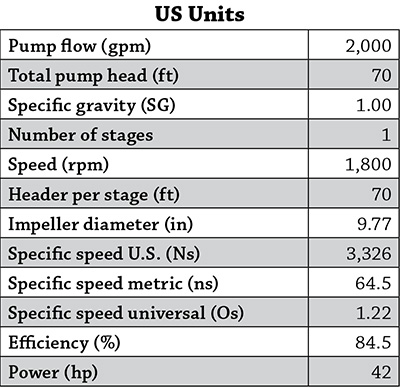08/22/2014
When the pump selection process starts, the required flow of the is often the only known variable for an application. For example, a system must move 2,000 gallons per minute (gpm) from a holding tank to another tank or process. What size pump do should be installed? The size and pressure of the piping and the power of the motor must also be determined. This column helps explain how to make these decisions.
Pump & Piping Size
The longer the piping, the more pressure its internal friction will generate. A good way to pick a pipe size is to calculate its diameter from an empirical but simple starting formula. This will help establish an approximate range. Pipe velocity is usually between 5 and 10 feet per second (ft/sec). The smaller a pipe’s diameter, the faster fluid flows through it. The larger the pipe, the more expensive it is. Also, flowing too slowly may cause particulate matter to settle and clog the line, but flowing too quickly will wear the pipe. The 5 to 10 ft/sec range is usually a good starting point. Equation 1 can used for a more accurate calculation. V = Q x 0.321 / A Equation 1 Where: V = velocity in ft/sec Q = flow in gpm A = pipe area in square inches (in2) In our example, 5 = 2,000 x 0.321 / A A = 2,000 x 0.321 / 5 = 128.4 in2 pipe area, or 12.8 inch diameter This diameter can round to a 12-inch pipe with a velocity of slightly more than 5 ft/sec. The next step is to figure out the amount of pressure in the system if the pump is 5,000 feet away from the process’discharge. This determination is more complicated because some hydraulic information is needed. Several options can provide this information: come to class, consult a piping friction loss chart or take my word for it that the losses for cold water at 2,000 gpm in a 12-inch, 5,000-foot pipe are about 70 feet. With the flow and head determined, the motor can be sized (see Table 1). Also, an online Efficiency Estimator, which can be found at www.mj-scope.com/pump_tools/pump_efficiency.htm, offers useful formulas. Table 1. Sizing motors during pump selection (graphics courtesy of the author)
Table 1. Sizing motors during pump selection (graphics courtesy of the author)
